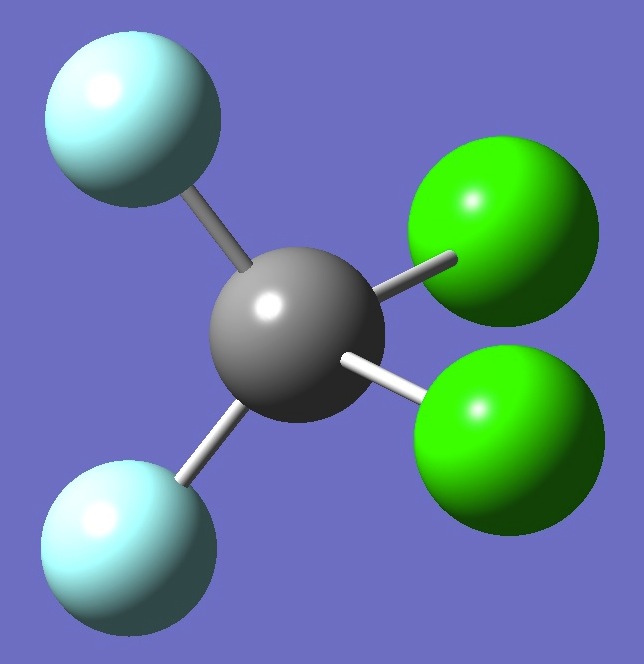|
|
|
|
|
|
|
|
|
|
|
|
|
|
|
|
|
|
|
|
|
CF2Cl2 |
|
|

|
|
|
|
|
|
|
|
|
|
|
|
|
|
|
|
|
|
|
|
|
|
|
|
|
|
|
|
|
|
|
|
Chlorine |
|
|
|
Nuclear
Quadrupole Coupling Constants |
|
|
|
in Dichlorodifluoromethane |
|
|
|
|
|
|
|
|
|
|
|
|
|
|
|
|
|
|
|
|
|
|
|
|
|
|
|
|
|
|
|
|
|
35Cl nqcc's in dichlorodifluorormethane have been determined
by Baskakov, et al. [1], Takeo and Matsumura [2], and Su and Beeson [3].
Davis et al. [4] determined substitution, effective, and average structures.
Takeo and Matsumura [2] and Su and Beeson [3] also determined substitution
structures. Vogt et al. [5] determined a semi-experimental equilibrium structure, reSE.
|
|
|
|
|
|
|
|
|
|
|
|
|
Chlorine nqcc's were calculated here on the
substitution structure of Davis et al. and on the reSE of Vogt et al. These are compared with the experimental
nqcc's of Baskakov et al. [1] in Table 1. Structure parameters are compared in Table
2. |
|
|
|
|
|
|
|
|
|
|
|
|
In Table 1, subscripts a,b,c refer to
principal axes of the inertia tensor; x,y,z to principal axes
of the nqcc tensor. ETA = (Xxx - Xyy)/Xzz.
Ø (degrees) is the angle between its subscripted
parameters.
|
|
|
RMS is the root mean square difference
between calculated and experimental diagonal nqcc's (percentage of the
average of the magnitudes of the experimental nqcc's). RSD is the
calibration residual standard deviation for the B1LYP/TZV(3df,2p) model
for calculation of the chlorine efg's/nqcc's. |
|
|
|
|
|
|
|
|
|
|
|
|
|
|
|
|
|
|
|
|
|
|
| |
|
|
|
|
|
|
|
|
|
Table 1. 35Cl
nqcc's in CF235Cl2 (MHz). Calculation was made on the rs structure of Davis et al. [4], and on the reSE structure of Vogt et al. [5]. |
|
| |
|
|
|
|
|
|
|
|
|
|
|
Calc /rs |
|
Calc /reSE |
|
Expt. [1] |
|
| |
|
|
|
|
|
|
|
|
|
Xaa |
- |
45.08 |
-
|
43.83
|
- |
43.688(33) |
|
|
Xbb |
|
6.11 |
|
4.89
|
|
4.6905 |
|
|
Xcc |
|
38.98 |
|
38.94
|
|
38.9975 |
|
|
Xab |
± |
54.09 |
± |
54.18
|
± |
52.7(46) |
|
|
|
|
|
|
|
|
|
|
|
RMS |
|
1.15 (3.9 %) |
|
0.15 (0.50 %)
|
|
|
|
|
RSD |
|
0.49 (1.1 %) |
|
0.49 (1.1 %) |
|
|
|
|
|
|
|
|
|
|
|
|
|
Xxx |
|
40.35 |
|
39.94
|
|
38.5 * |
|
|
Xyy |
|
38.98 |
|
38.94 |
|
38.9975 |
|
|
Xzz |
- |
79.32 |
-
|
78.88
|
- |
77.5 |
|
|
ETA |
- |
0.017 |
-
|
0.013
|
- |
0.006 |
|
|
Øz,b |
|
57.66 |
|
57.10
|
|
57.33 |
|
|
Øb,CCl |
|
56.3 |
|
55.81
|
|
|
|
|
Øz,CCl |
|
1.4 |
|
1.29
|
|
|
|
|
|
|
|
|
|
|
|
|
|
|
|
|
|
|
|
|
|
|
|
|
|
* Principal values of the nqcc tensor calculated here from the experimental data. |
|
|
|
|
|
|
|
|
|
|
|
|
| |
|
|
|
|
|
|
| Table 2. CF2Cl2 Molecular structure parameters (Å and degrees). |
|
|
|
|
|
|
|
|
|
rs
[4] |
ro
[4] |
rz
[4] |
rs
[2] |
rs
[3] | reSE [5] |
|
|
|
|
|
|
|
| CCl |
1.744 |
1.742 |
1.745 |
1.744 |
1.738 | 1.7519(7)
|
| CF |
1.347 |
1.349 |
1.347 |
1.345 |
1.358 | 1.3287(8)
|
| FCF |
106.2 |
105.9 |
106.2 |
106.23 |
105.4 | 107.75(9)
|
| ClCCl |
112.6 |
113.0 |
112.7 |
112.55 |
113.2 | 111.62(7)
|
|
|
|
|
|
|
|
|
|
|
|
|
|
|
|
|
|
|
|
|
|
|
|
[1] O.I.Baskakov, S.F.Dyubko, A.A.Katrich, V.V.Ilyushin, and E.A.Alekseev,
J.Mol.Spectrosc. 199,26(2000). |
|
|
[2] H.Takeo and C.Matsumura, Bull.Chem.Soc.Jpn. 50,636(1977). |
|
|
[3] C.F.Su and E.L.Beeson Jr., J.Chem.Phys. 66,330(1977). |
|
|
[4] R.W. Davis, M.C.L.Gerry, and C.J.Marsden, J.Mol. Spectrosc. 101,167(1983). |
|
|
[5] N.Vogt, J.Demaison, and H.D.Rudolph, Mol.Phys. 112,2873(2014).
|
|
|
|
|
|
|
|
|
|
|
|
|
|
|
|
|
|
|
|
|
|
|
CF3Cl |
CFCl3 |
CH2FCl |
CHF2Cl |
|
|
CH3Cl |
CH2Cl2 |
CHCl3 |
|
|
|
|
|
|
|
|
|
|
|
|
|
Calculation of Nuclear Quadrupole Coupling Constants on Approximate Equilibrium Structures of Chlorofluoromethanes. |
|
|
|
|
|
|
|
|
|
|
|
|
|
|
|
|
|
|
|
|
|
|
Table of Contents |
|
|
|
|
|
Molecules/Chlorine |
|
|
|
|
|
|
|
|
|
|
|
|
|
|
|
|
|
|
|
|
|
|
|
|
|
|
|
|
|
|
CF2Cl2.html |
|
|
|
|
|
|
Last
Modified 5 July 2014 |
|
|
|
|
|
|
|
|
|
|
